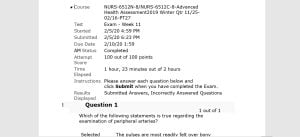COURSE
NURS 6512 Advanced Health Assessment and Diagnostic
Number of Questions 1 – 100
- Question: Part of the screening orthopedic component of the examination includes evaluating the person while he or she is:
- Question: During chest assessment, you note the patient’s voice quality while auscultating the lung fields. The voice sound is intensified, there is a nasal quality to the voice, and the e’s sound like a s. This sound is indicative of:
- Question: Tarry black stool should make you suspect:
- Question: To assess a cremasteric reflex, the examiner strokes the:
- Question:The family history for a patient with joint pain should include information about siblings with:
- Question: A finding that is indicative of osteoarthritis is:
- Question: When palpating joints, crepitus may occur when:
- Question: Palpation of a normal prostate in an older adult is likely to feel:
- Question: As Mr. B. enters the room, you observe that his gait is wide based and he staggers from side to side while swaying his trunk. You would document Mr. B.’s pattern as:
- Question: Montgomery tubercles are most prominent in the breasts of:
- Question: When you attempt to move a 10-month-old child from his mother’s lap to the examination table, he screams loudly. Your best action is to:
- Question: Which medical condition would exclude a person from sports participation?
- Question: The strength of the trapezius muscle is evaluated by having the patient:
- Question: At your first meeting with a patient, it is usually best to say:
- Question: The best way to ease the apprehension of a 3-year-old child before a physical examination is to:
- Question: The examiner percusses for diaphragmatic excursion along the:
- Question: Electrical activity recorded by the electrocardiogram (ECG) tracing that denotes the spread of the stimulus through the atria is the:
- Question: When the Goodenough-Harris Drawing Test is administered to a child, the evaluator principally observes the:
- Question: You are examining Mr. S., a 79-year-old diabetic man complaining of claudication. Which of the following physical findings is consistent with the diagnosis of arterial occlusion?
- Question: The Mini-Mental State Examination should be administered for the patient who:
- Question: Normal changes of the aging brain include:
- Question: When assessing superficial pain, touch, vibration, and position perceptions, you are testing:
- Question: Anterior cruciate ligament integrity is assessed via the _____ test.
- Question: Breath odors may clue the examiner to certain underlying metabolic conditions. The odor of ammonia on the breath may signify:
- Question: To hear diastolic heart sounds, you should ask patients to:
- Question: Cranial nerve XII may be assessed in an infant by:
- Question: Which cranial nerves are usually evaluated during the examination of the eyes
- Question: The foramen ovale should close:
- Question: Temporalis and masseter muscles are evaluated by:
- Question: A grade IV mitral regurgitation murmur would:
- Question: The checkout station for preparticipation physical evaluation (PPE) is critical because at this point:
- Question: You are assessing Mr. Z.’s fluid volume status as a result of heart failure. If your finger depresses a patient’s edematous ankle to a depth of 6 mm, you should record this pitting as:
- Question: A patient you are seeing in the emergency department for chest pain is suspected of having a myocardial infarction. During the health history interview of his family history, he relates that his father had died of “heart trouble.” The most important follow-up question you should pose is which of the following?
- Question: To assess spinal levels L2, L3, and L4, which deep tendon reflex should be tested?
- Question: A 12-year-old boy relates that his left scrotum has a soft swollen mass. The scrotum is not painful upon palpation. The left inguinal canal is without masses. The mass does transilluminate with a penlight. This collection of symptoms is consistent with:
- Question: Inquiry about nocturnal muscle spasms would be most significant when taking the musculoskeletal history of:
- Question: Bimanual examination of the uterus includes:
- Question: The difference in blood pressure readings between the right and the left arms is considered normal up to _____ mm Hg.
- Question: You are performing a two-point discrimination test as part of a well physical examination. The area with the ability to discern two points in the shortest distance is the:………………………..
ANSWERS

………..please click the icon below to purchase full exam at $18